Comparative Study on Shaking Table Tests for a Pile–Nuclear Island Structure under Different Soil Conditions
Abstract
:1. Introduction
2. The Facilities and Design of the Test
2.1. The Shaking Table System
2.2. The Layered Shear Soil Box
2.3. Soil Model in the Test
2.4. Model of the Pile Foundation and the Containment
2.5. The Sensors Layout and the Data Acquisition System
2.6. The Seismic Motion Input
3. Macroscopic Phenomenon of Pile Foundation in the Test
4. Analysis of Test Results
4.1. Acceleration Response of Nuclear Island Containment
4.2. Displacement Response of Pile Foundation
4.3. Bending Moment Response of Pile Foundation
5. Numerical Simulation
5.1. The Finite Element Model
5.2. Development Process of the Plastic Damage
6. Conclusions
- (1)
- When the amplitude of the input seismic motion is small (less than 0.2 g in this paper), the peak acceleration amplification factor of the nuclear island plant in the medium-soft soil site is larger than that in the hard soil site. However, when the amplitude of the input seismic motion is large (0.4 g in this paper), the peak acceleration amplification factor of the upper nuclear island structure is smaller than that in the hard soil site because the medium-soft soil has entered a strong nonlinear stage, and the pile foundation has been damaged.
- (2)
- The properties of the soil around the pile foundation have a significant effect on the response characteristics of the superstructure. The predominant period value of the floor spectrum of the nuclear island plant in the soft soil site is greater than that in the hard soil site. Resonance occurs when the predominant period value of the floor spectrum is similar to that of the far-field seismic motion response spectrum, which aggravates the vibration of the plant structure and its pile foundation, resulting in great damage to the structural system.
- (3)
- The properties of site soil have a great influence on the seismic damage of piles. The deformation constraint effect of soil on piles is small under the action of the seismic motion when the site soil is soft, and it is easy for the separation phenomenon between piles and soil to occur, resulting in the large displacement and deformation of piles, which may cause damage to the pile foundation.
- (4)
- The internal force of piles is also related to the position of the pile in the pile group. The piles at the edge along the direction of the seismic motion input of the pile group have a large internal force and the most serious damage. Therefore, attention should be paid to strengthening the protection of the side piles in the seismic design of the nuclear island containment structure.
- (5)
- The pile failure is most likely to occur at the head, which is damaged by the combined action of bending, shear and pressure with the increase in seismic motion amplitude when the site soil is soft, followed by the possible bending failure of the pile body.
Author Contributions
Funding
Institutional Review Board Statement
Informed Consent Statement
Data Availability Statement
Conflicts of Interest
References
- Yang, Y.; Wu, H.; Fang, Q. Numerical simulation analyses of damage and vibration response of a nuclear power plant under aircraft impact. J. Vib. Shock 2023, 42, 312–324. [Google Scholar]
- Yang, J.; Ma, Y.; Cai, L.; Shen, L. Research on the seismic response analysis of nuclear island buildings with pile foundation. Ind. Constr. 2021, 51, 31–36. [Google Scholar]
- Tian, Z.; Li, P.; Zhu, S.; Zhang, Y.; Li, Y.; Liu, Y.; Zhou, K.; Yan, L. Shaking table tests on negative friction of piles in soft soils under strong earthquake motion. Chin. J. Geotech. Eng. 2022, 44, 550–559. [Google Scholar]
- Zhuang, H.; Zhao, C.; Yu, X.; Chen, G. Earthquake responses of piles-soil dynamic interaction system for base-isolated structure system based on shaking table tests. Chin. J. Geotech. Eng. 2022, 44, 979–987. [Google Scholar]
- Liang, F.; Liang, X.; Zhang, H. Simplified analysis of dynamic response of pile-supported bridge under local scour and verification by centrifugal shaking tests. Chin. J. Geotech. Eng. 2021, 43, 1771–1780. [Google Scholar]
- Meymand, P. Shaking Table Scale Model Tests of Nonlinear Soil-Pile-Superstructure Interaction in Soft Clay; University of California: Berkeley, CA, USA, 1998. [Google Scholar]
- Wei, X. Shake Table Tests of Soil-Pile-Structure Interaction and Its Theoretical Analysis; Tongji University: Shanghai, China, 1999. [Google Scholar]
- Wu, X. Shake Table Tests of Sand-Pile-Structure Interaction; Tongji University: Shanghai, China, 2002. [Google Scholar]
- Chen, G.; Wang, Z.; Zuo, X.; Du, X.; Han, X. Development of laminar shear soil container for shaking table tests. Chin. J. Geotech. Eng. 2010, 32, 89–97. [Google Scholar]
- Sun, H.; Jing, L.; Meng, X.; Wang, N. A three-dimensional laminar shear soil container for shaking table test. J. Vib. Shock 2012, 31, 26–32. [Google Scholar]
- Ni, K. Shaking Table Test of Pile and Composite Foundations’ Dynamic Behavior in Layered Soils Subjected to Earthquake Excitation; China Academy of Building Research: Beijing, China, 2013. [Google Scholar]
- Chau, K.; Shen, C.; Guo, X. Nonlinear seismic soil–pile–structure interactions: Shaking table tests and FEM analyses. Soil Dyn. Earthq. Eng. 2008, 29, 300–310. [Google Scholar] [CrossRef]
- Tokimatsu, K.; Suzuki, H.; Sato, M. Effects of inertial and kinematic interaction on seismic behavior of pile with embedded foundation. Soil Dynamatics Earthq. Eng. 2005, 25, 753–762. [Google Scholar] [CrossRef]
- Hokmabadi, A.S.; Fatahi, B.; Samali, B. Physical Modeling of Seismic Soil-Pile-Structure Interaction for Buildings on Soft Soils. Int. J. Geomech. 2015, 15, 04014046. [Google Scholar] [CrossRef]
- Huang, Z.; Bai, X. Shaking table model test for seismic response of a pile group foundation with liquefiable sandy soil. J. Vib. Shock 2013, 32, 153–158. [Google Scholar]
- Li, X.; Wang, X.; He, Q.; Liu, A. Shaking Table Test for Evaluation of Seismic Behavior of Nuclear Power Plants on Non-Rock Site. Nucl. Power Eng. 2017, 38, 31–35. [Google Scholar]
- Jing, L.; Wang, G.; Li, J.; Sun, Y.; Zhou, Z.; Qi, W. Shaking Table Test and Numerical Simulation of Soil-Pile-Nuclear Island System Dynamic Interaction. Chin. J. Geotech. Eng. 2022, 44, 163–172. [Google Scholar]
- Hu, C.; Yang, X. Analysis of seismic response on pile in liquefiable site. J. Vib. Shock 2007, 106, 133–137. [Google Scholar]
- Zhang, Y.; Li, J. Numerical solution of pile-soil interaction problem in ocean. J. Vib. Shock 2009, 28, 160–163. [Google Scholar]
- Luo, C.; Zhan, C.; Lou, Y.; Jin, X.; Ding, Z. Effects of pile-soil nonlinear coupling actions on dynamic response features of pile foundation under earthquake. J. Vib. Shock 2017, 36, 20–26. [Google Scholar]

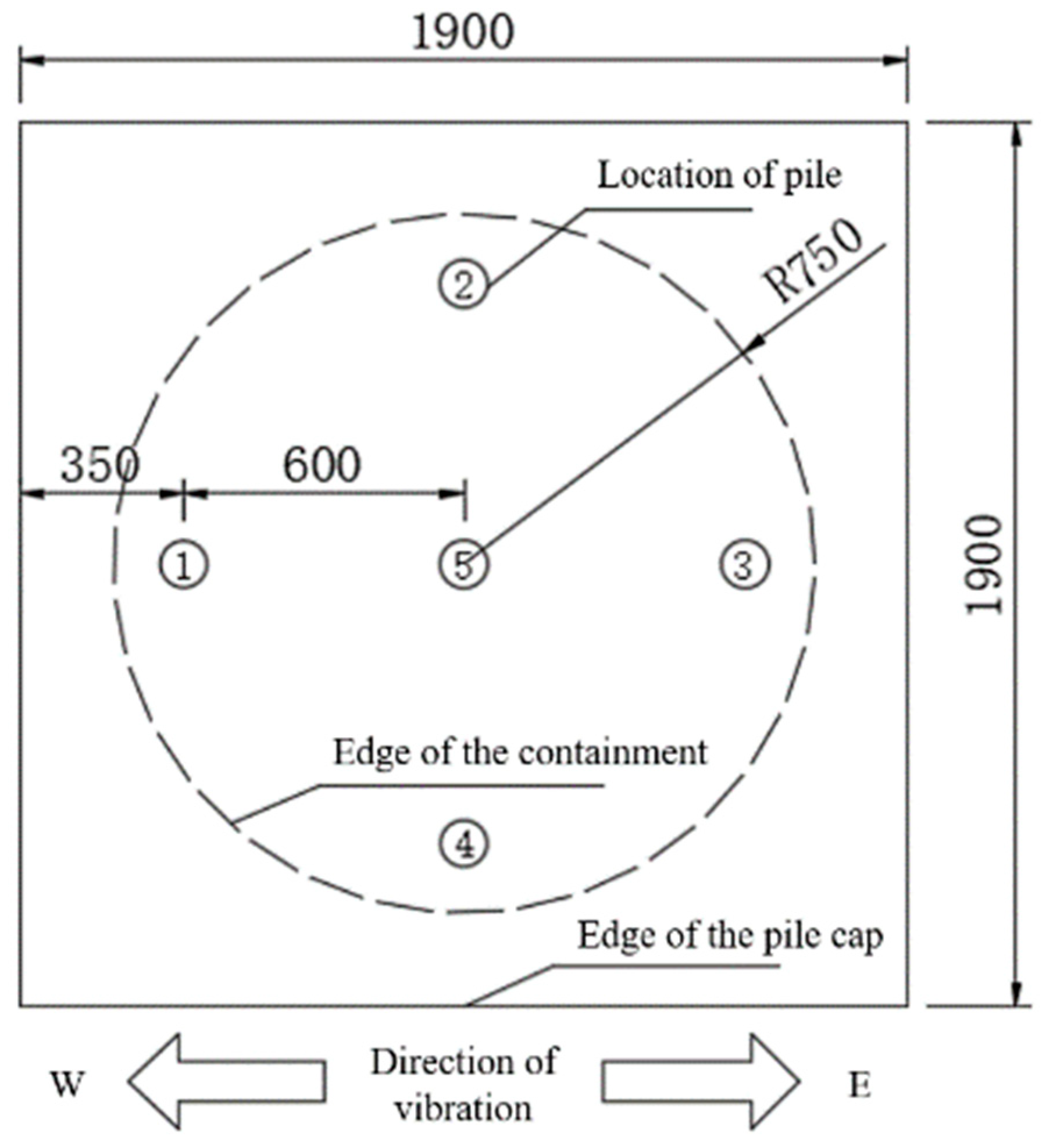

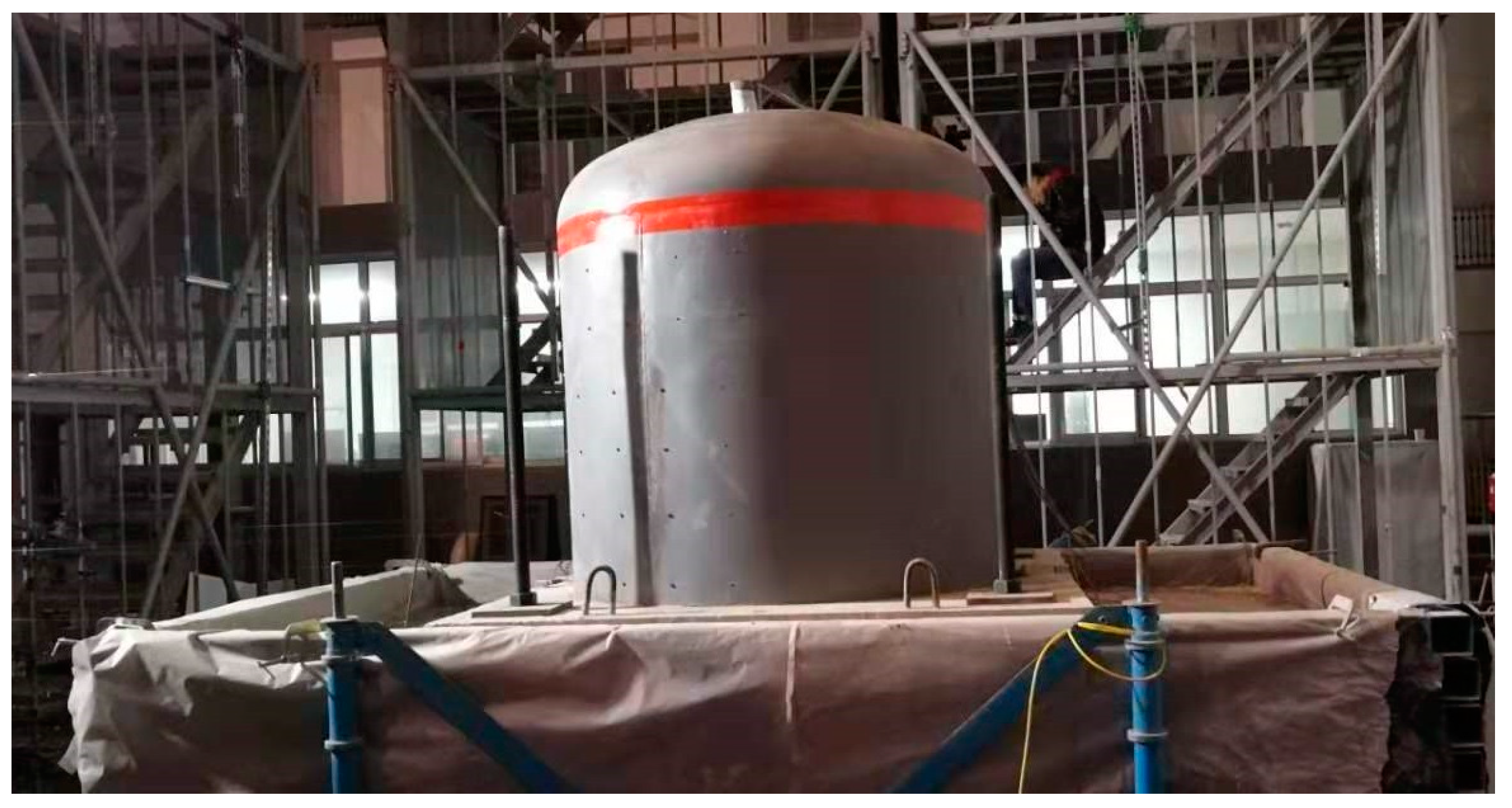



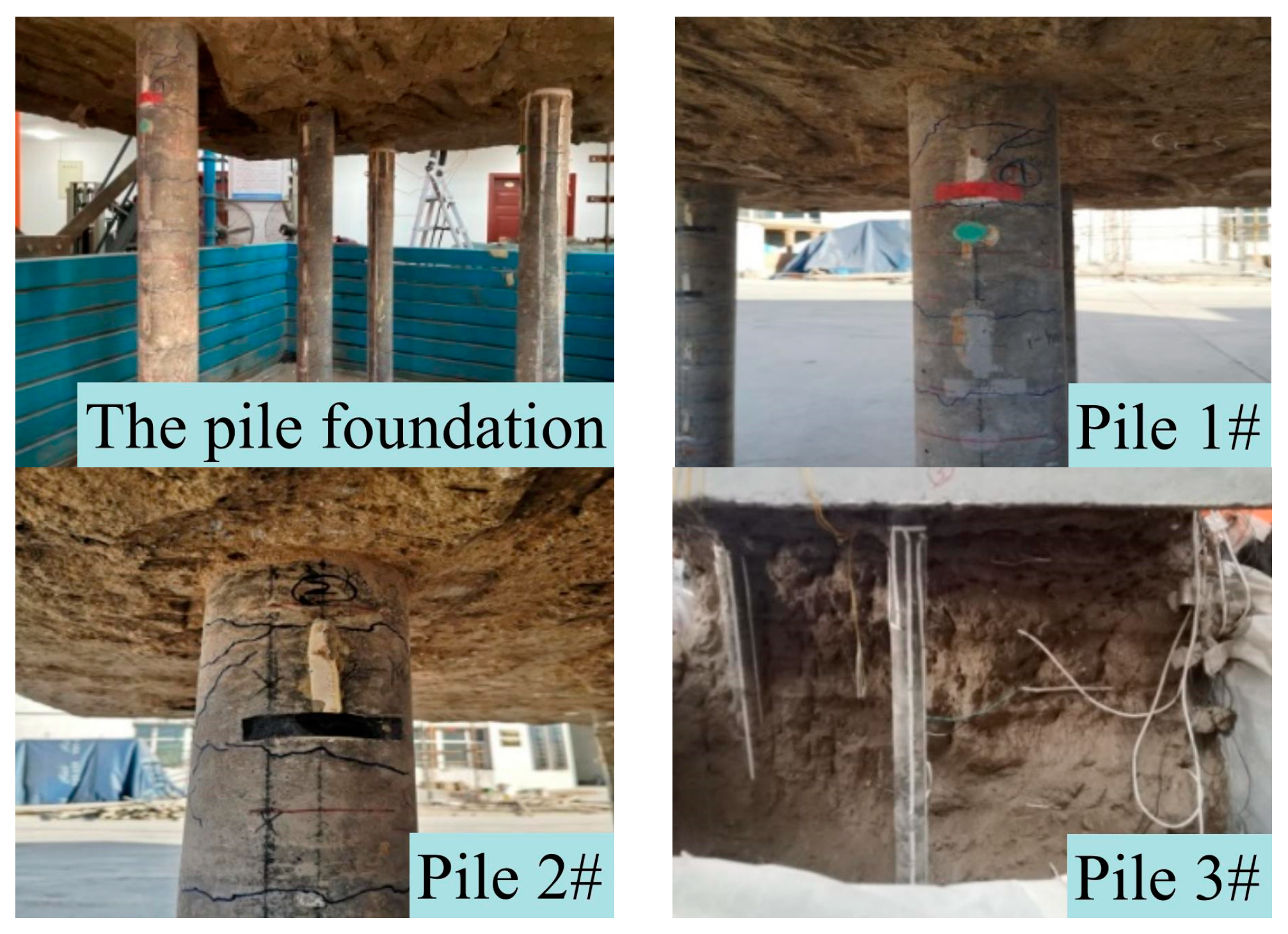
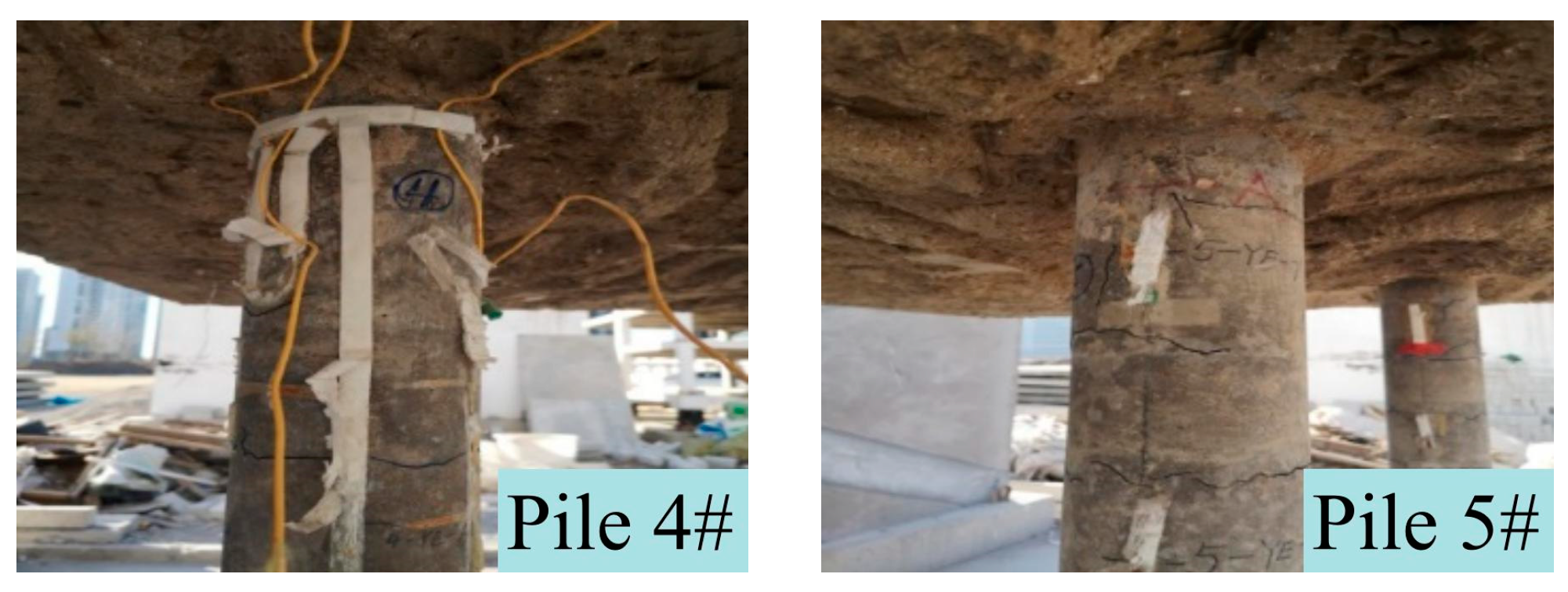


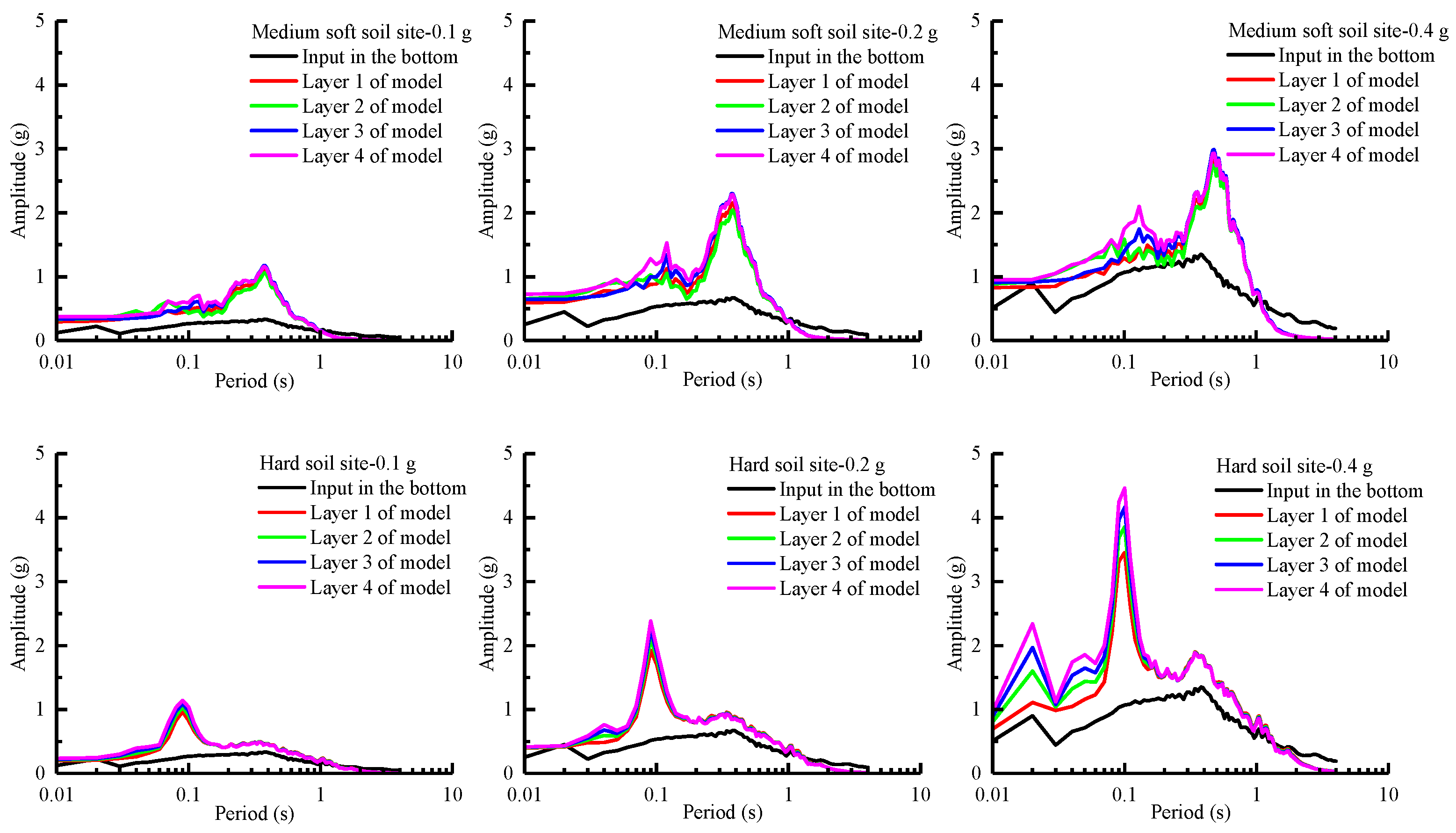
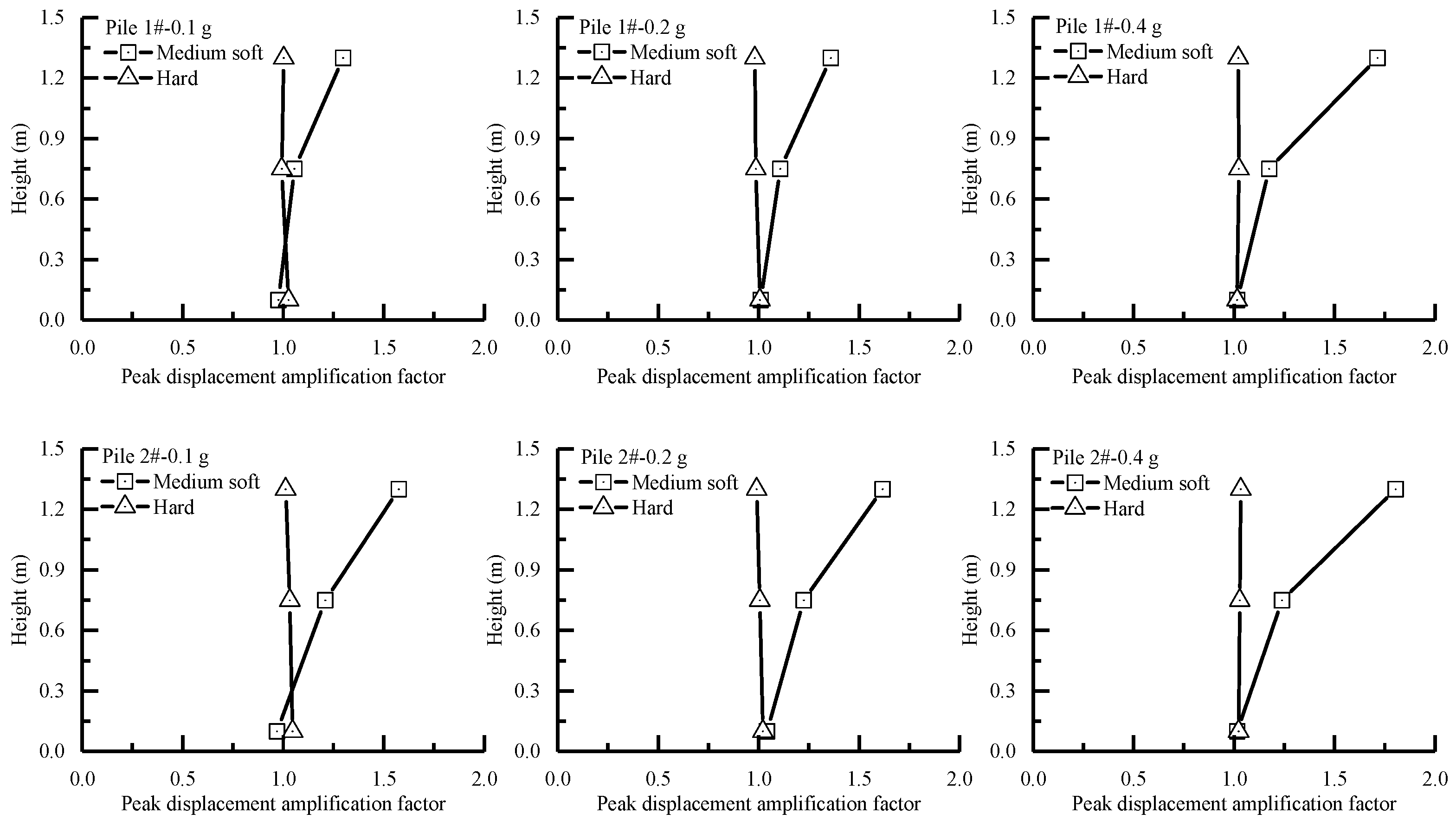
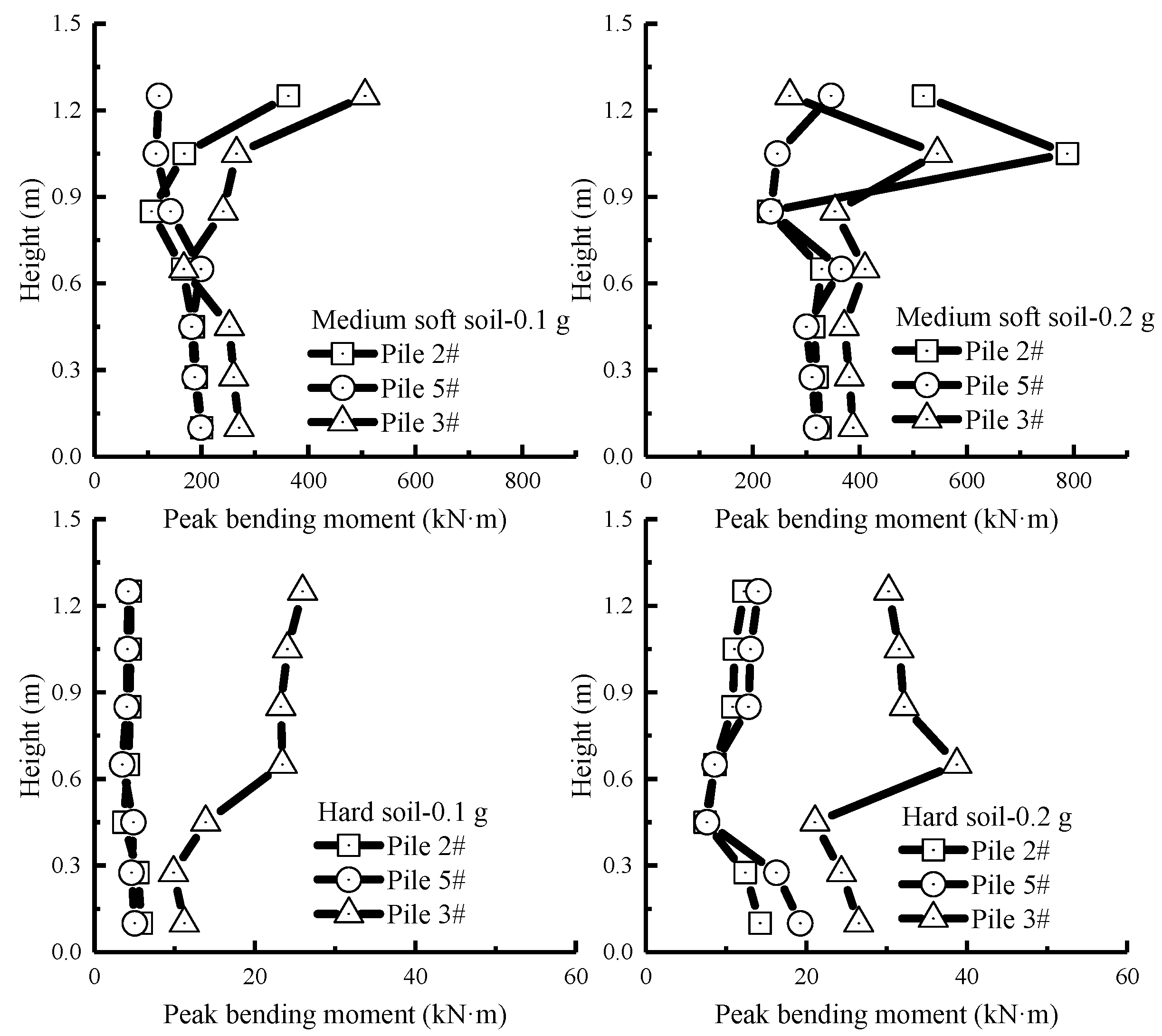
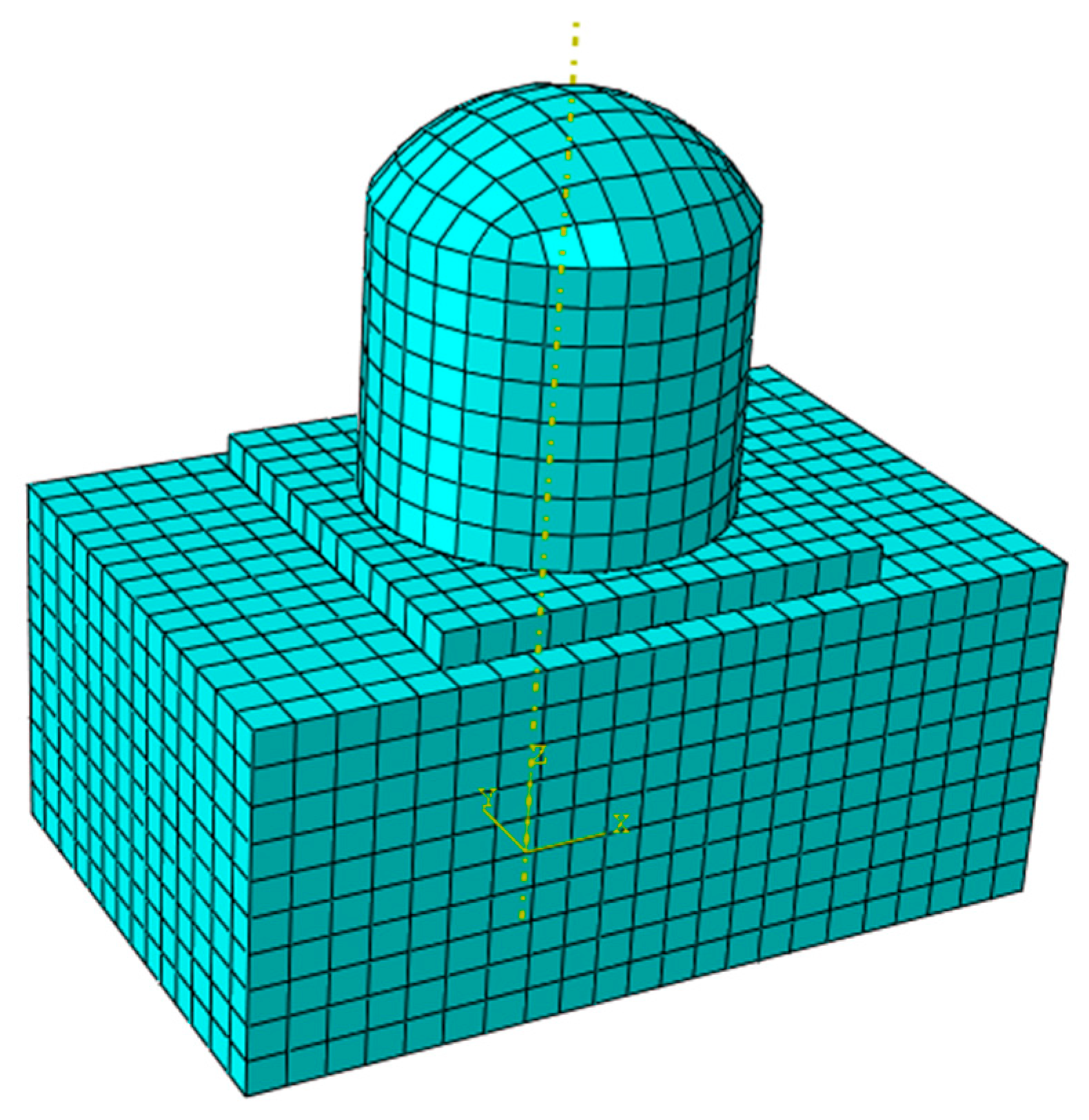
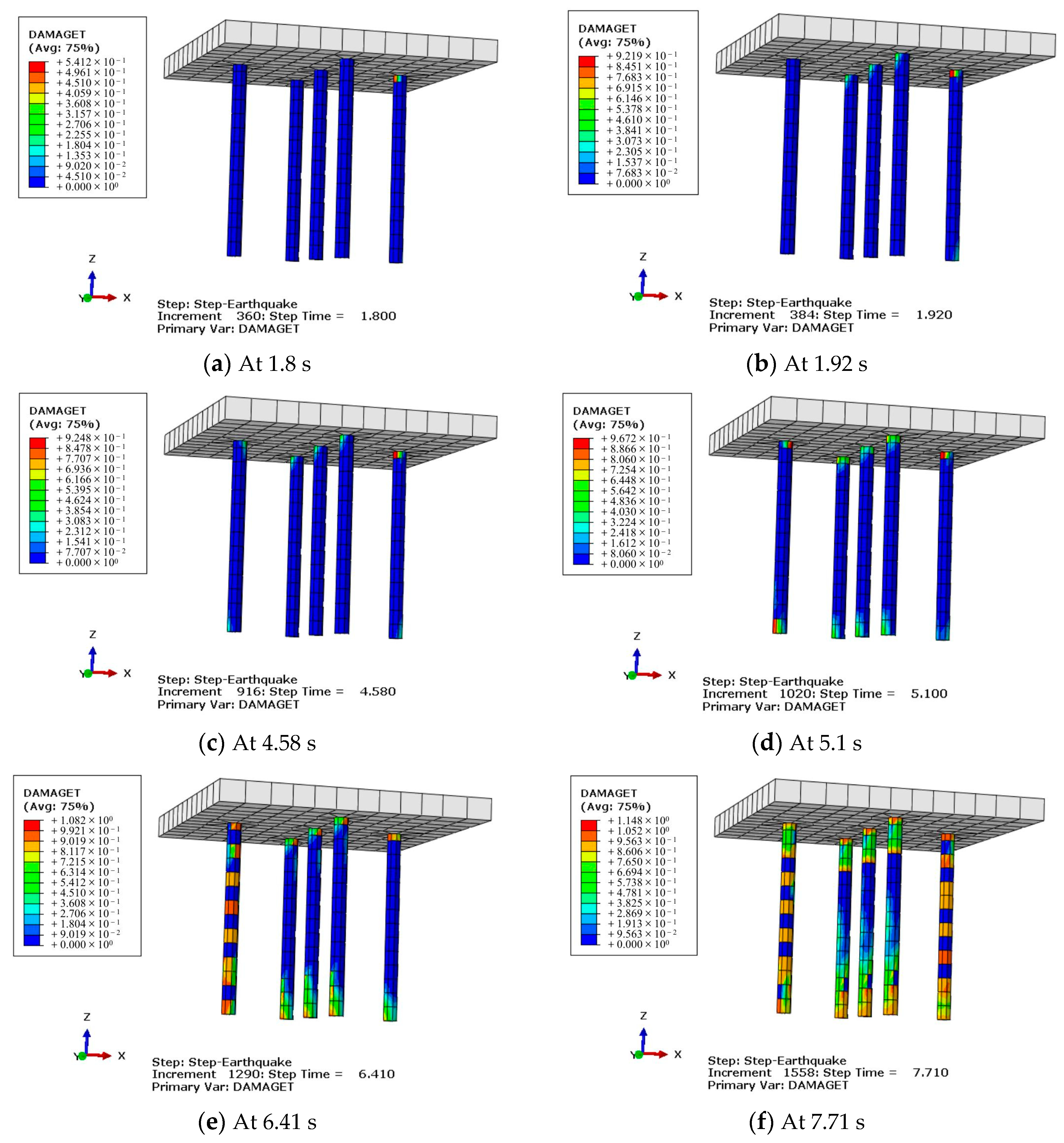
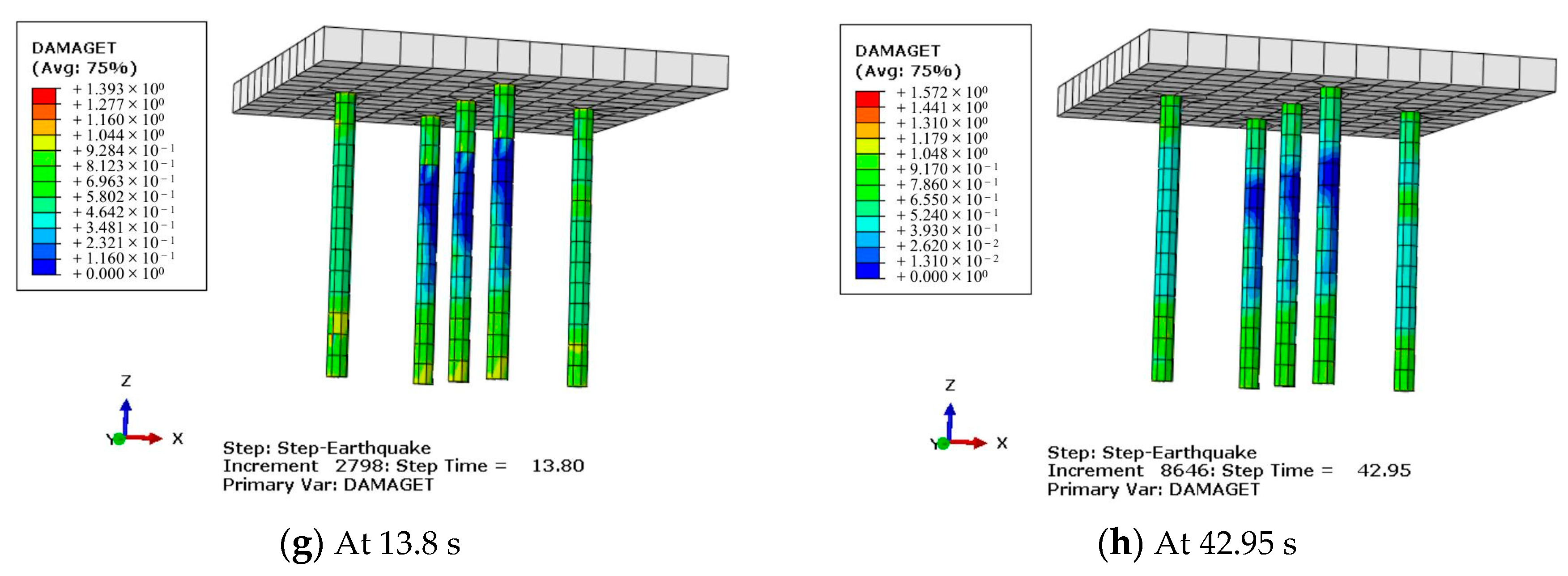
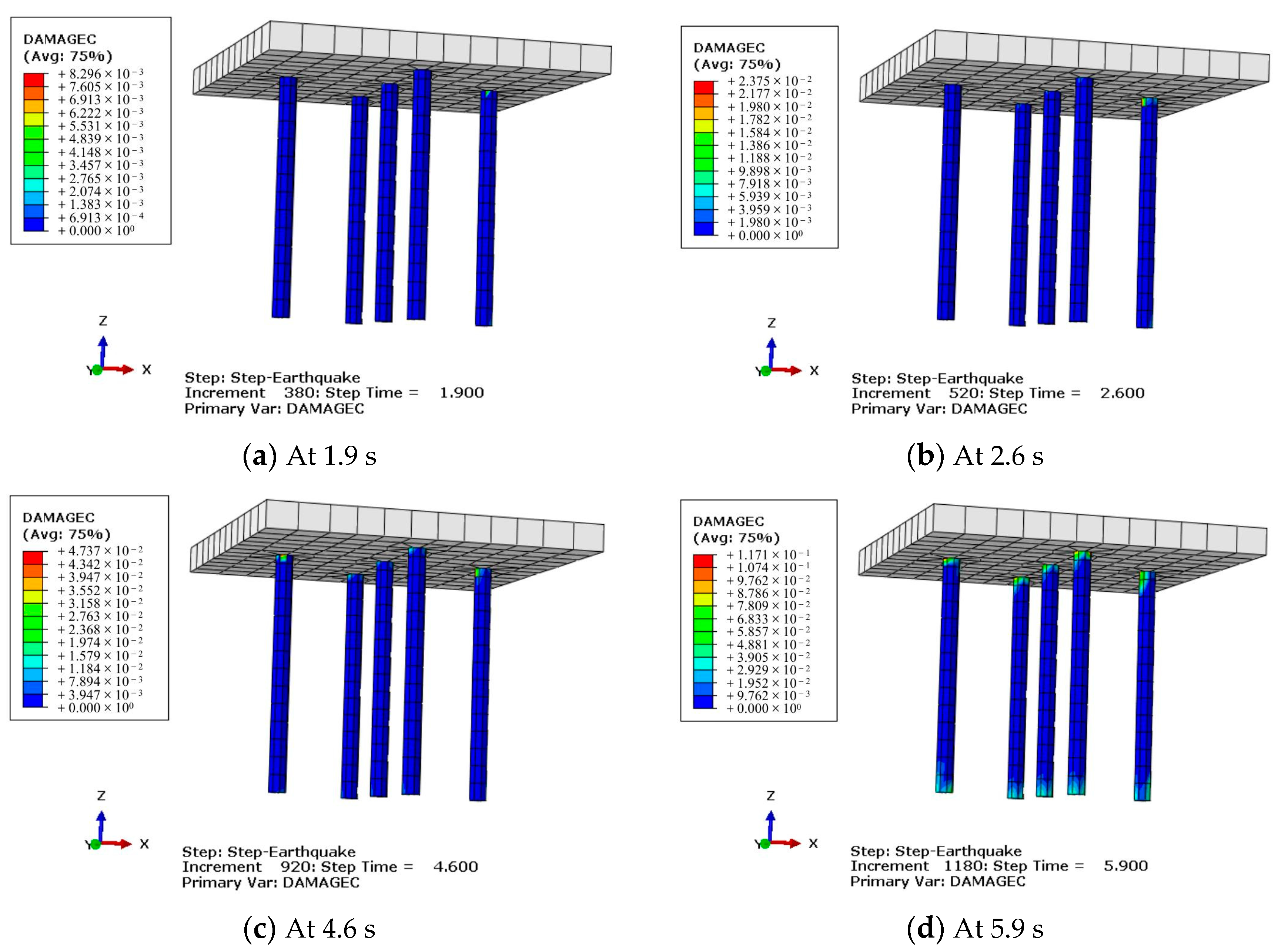
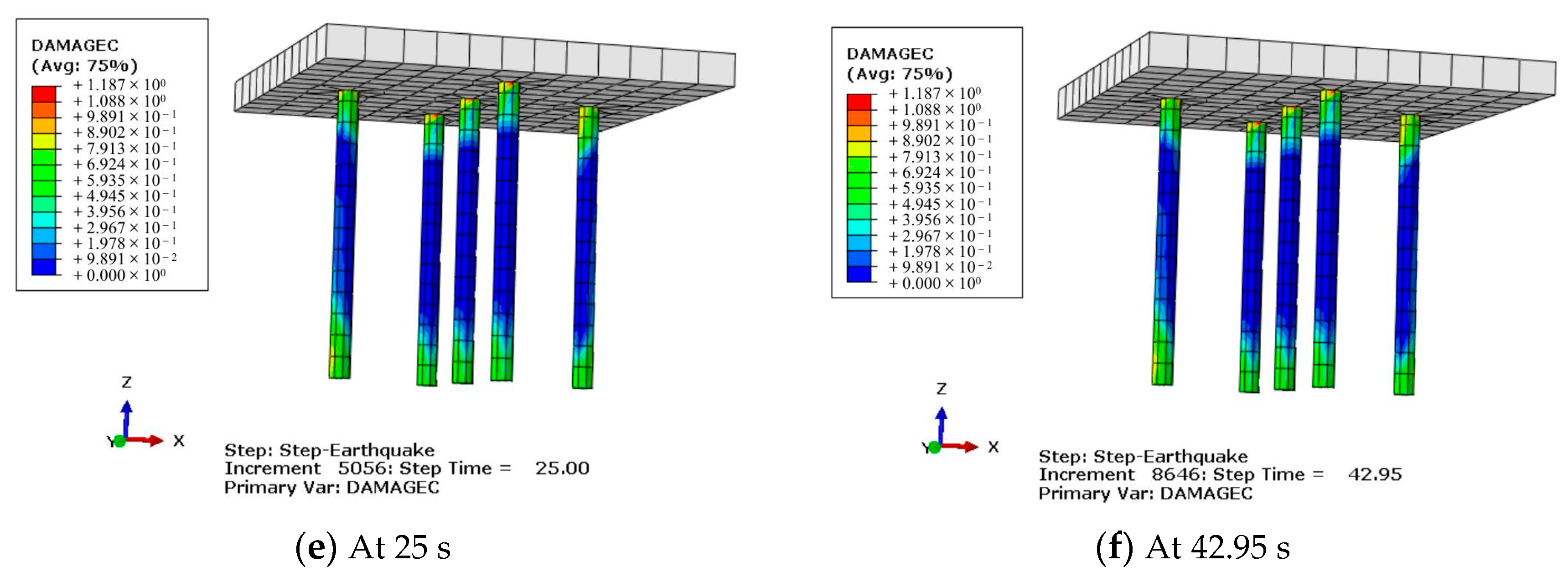
| Item | Density (kg/m3) | Elastic Modulus (kPa) | Poisson’s Ratio | Cohesion (kPa) | Friction Angle (°) | Dilation Angle (°) |
|---|---|---|---|---|---|---|
| Soil surface | 1700 | 1 | 0.35 | 0.01 | 20 | 0.1 |
| Soil bottom | 1700 | 15,000 | 0.35 | 25 | 20 | 0.1 |
| Item | Density (kg/m3) | Elastic Modulus (Gpa) | Poisson’s Ratio | Cohesion (°) | Eccentricity | fb0/fc0 | Kc |
|---|---|---|---|---|---|---|---|
| Value | 2400 | 22 | 0.2 | 35 | 0.1 | 1.16 | 0.6667 |
| Item | Density (kg/m3) | Elastic Modulus (Gpa) | Poisson’s Ratio | Yield Stress (Mpa) |
|---|---|---|---|---|
| Longitudinal reinforcement | 7800 | 200 | 0.2 | 335 |
| stirrup | 7800 | 200 | 0.2 | 235 |
| Item | Density (kg/m3) | Elastic Modulus (Gpa) | Poisson’s Ratio |
|---|---|---|---|
| Pile cap | 2500 | 100 | 0.2 |
| Baseplate of nuclear island | 2500 | 100 | 0.2 |
| Nuclear island containment | 17,900 | 200 | 0.2 |
Disclaimer/Publisher’s Note: The statements, opinions and data contained in all publications are solely those of the individual author(s) and contributor(s) and not of MDPI and/or the editor(s). MDPI and/or the editor(s) disclaim responsibility for any injury to people or property resulting from any ideas, methods, instructions or products referred to in the content. |
© 2023 by the authors. Licensee MDPI, Basel, Switzerland. This article is an open access article distributed under the terms and conditions of the Creative Commons Attribution (CC BY) license (https://creativecommons.org/licenses/by/4.0/).
Share and Cite
Sun, Y.; Wang, G.; Wang, Y.; Tu, J.; Jing, L.; Qi, W. Comparative Study on Shaking Table Tests for a Pile–Nuclear Island Structure under Different Soil Conditions. Sustainability 2023, 15, 11988. https://doi.org/10.3390/su151511988
Sun Y, Wang G, Wang Y, Tu J, Jing L, Qi W. Comparative Study on Shaking Table Tests for a Pile–Nuclear Island Structure under Different Soil Conditions. Sustainability. 2023; 15(15):11988. https://doi.org/10.3390/su151511988
Chicago/Turabian StyleSun, Yunlun, Gang Wang, Yougang Wang, Jian Tu, Liping Jing, and Wenhao Qi. 2023. "Comparative Study on Shaking Table Tests for a Pile–Nuclear Island Structure under Different Soil Conditions" Sustainability 15, no. 15: 11988. https://doi.org/10.3390/su151511988
APA StyleSun, Y., Wang, G., Wang, Y., Tu, J., Jing, L., & Qi, W. (2023). Comparative Study on Shaking Table Tests for a Pile–Nuclear Island Structure under Different Soil Conditions. Sustainability, 15(15), 11988. https://doi.org/10.3390/su151511988








